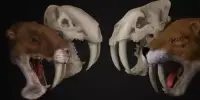The first known instance of a theropod dinosaur that is streamlined and can walk on two legs that is not an avian has been discovered by a team of scientists from Seoul National University, the University of Alberta, and the Mongolian Academy of Sciences. The group details the location of the fossil, its state, and the characteristics that were utilized to help identify it as a new dinosaur species in their report that was published in Communications Biology.
The dinosaur was discovered in 2008 during the Korean-Mongolian International Dinosaur Expedition at the Hermiin Tsav fossil formation in Mongolia. Since then, it has been kept in storage alongside hundreds of other fossils as scientists examine them.
The majority of the dinosaur’s two hindlimbs, one of its forelimbs, most of its skull, and most of its spinal column were all present, the researchers discovered after studying the fossil. It also had a mouthful of teeth.
The bones was sleek and trim, like many contemporary water birds, which led the researchers to conclude that the animal probably lived on or near the ocean and subsisted by offshore fishing.
The scientists also observed that it had ribs that pointed toward its tail, which is another characteristic of waterbirds. There were no signs of wings, hence it was not an avian. The skeleton’s general morphology, which likely gave the animal a penguin-like gait, strongly suggested that it did not need its forelimbs for walking, the researchers added.
Their findings suggest the dinosaur belonged to the therapod family and had not been identified before; thus, it represented a newly discovered species. They named it Natovenator polydontus, which roughly translates to “hunter that swims and has a lot of teeth.” They suggest it also most closely resembled Halszkaraptor, another non-avian dinosaur that also lived in what is now Mongolia.
The dinosaur was found in a rock formation dating from the Upper Cretaceous, which places it to roughly 100 million to 66 million years ago. Although its vast number of teeth suggests it had a more diversified diet, the researchers contend that it was evolved to a semiaquatic existence comparable to that of modern water birds.
















